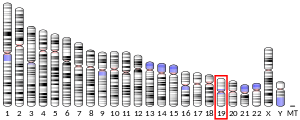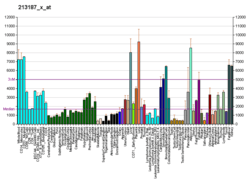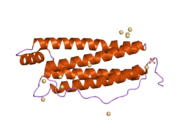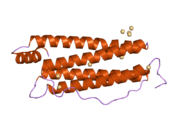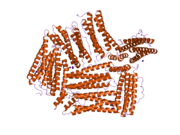Ferritin light chain
Ferritin light chain is a protein that in humans is encoded by the FTL gene.[4][5][6] Ferritin is the major protein responsible for storing intracellular iron in prokaryotes and eukaryotes. It is a heteropolymer consisting of 24 subunits, heavy and light ferritin chains.[6] This gene has multiple pseudogenes.[6]
It is abnormally expressed in fetuses of both IVF and ICSI, which may contribute to the increase risk of birth defects in these ART.[7]
Function
Iron is extremely important in the development of neurons, transport through iron-sulfur clusters, the electron transport chain, and synthesis and breakdown of neurotransmitters. The function of the FTL is to act as both an iron reservoir and to remove excess iron from the body. Since iron plays a role in electron transfer, there is potential for the generation of free, highly toxic radicals which makes the role of the FTL as an iron detoxifier very significant.[8] The rates of iron uptake and release may be affected by changes to the components of the ferritin light chains and heavy chains.[6] Although the ferritin light chain unlike the ferritin heavy chain has no ferroxidase activity, the light chain may be responsible for the electron transfer across the ferritin protein cage.[9]
Clinical significance
Oxidative stress caused by iron radicals generated in the ETC and an increase in iron levels caused by defects in the FTL gene has been known to be a cause of the onset of neurodegenerative diseases and hyperferritinemia-cataract syndrome. [8][10]
Mutations of the FTL gene cause the rare adult-onset basal ganglia disease also known as neuroferritinopathy.[11] These mutations are specifically in exon four of the FTL gene. There are two distinct toxic mechanisms that lead to neuroferritinopathy and these are abnormalities in iron metabolism and the creation of free iron radicals, resulting in oxidative stress and cell death.[12]
Interactions
Ferritin light chain has been shown to interact with FTH1.[13][14] An oxygen molecule acts as the terminal electron acceptor during the oxidation of iron in aerobic metabolism. A study conducted with different apoferritins with distinct compositions of heavy and light subunits revealed that both subunits have key roles in the electron transport chain.[9] Neither subunit on its own has the ability to reduce Cytochrome c and thus the first step, the oxidation of Fe2+ to Fe3+, can be carried out by the heavy chain and the light chains are responsible for the transfer of electrons.[9]
FTL is regulated by iron and with an increase in iron, there is both an increase in the FTL expression and PEN-2 levels, which results in increased γ- secretase activity. In relation to this, the downregulation of FTL expression leads to a decrease in the protein levels of PEN-2.[15]
See also
References
- GRCh38: Ensembl release 89: ENSG00000087086 - Ensembl, May 2017
- "Human PubMed Reference:". National Center for Biotechnology Information, U.S. National Library of Medicine.
- "Mouse PubMed Reference:". National Center for Biotechnology Information, U.S. National Library of Medicine.
- Lebo RV, Kan YW, Cheung MC, Jain SK, Drysdale J (December 1985). "Human ferritin light chain gene sequences mapped to several sorted chromosomes". Hum. Genet. 71 (4): 325–8. doi:10.1007/BF00388458. PMID 3000916.
- Gasparini P, Calvano S, Memeo E, Bisceglia L, Zelante L (Apr 1997). "Assignment of ferritin L gene (FTL) to human chromosome band 19q13.3 by in situ hybridization". Ann. Genet. 40 (4): 227–8. PMID 9526618.
- "FTL ferritin, light polypeptide". National Center for Biotechnology Information. 5 July 2009. Retrieved 20 July 2009.
- Zhang Y, Zhang YL, Feng C, Wu YT, Liu AX, Sheng JZ, Cai J, Huang HF (October 2008). "Comparative proteomic analysis of human placenta derived from assisted reproductive technology". Proteomics. 8 (20): 4344–56. doi:10.1002/pmic.200800294. PMID 18792929.
- Vidal, Ruben; Miravalle, Leticia; Gao, Xiaoying; Barbeito, Ana G.; Baraibar, Martin A.; Hekmatyar, Shahryar K.; Widel, Mario; Bansal, Navin; Delisle, Marie B.; Ghetti, Bernardino (2008-01-02). "Expression of a Mutant Form of the Ferritin Light Chain Gene Induces Neurodegeneration and Iron Overload in Transgenic Mice". The Journal of Neuroscience. 28 (1): 60–67. doi:10.1523/JNEUROSCI.3962-07.2008. ISSN 0270-6474. PMC 2394191. PMID 18171923.
- Carmona U, Li L, Zhang L, Knez M (2014). "Ferritin light-chain subunits: key elements for the electron transfer across the protein cage". Chemical Communications. 50 (97): 15358–15361. doi:10.1039/c4cc07996e. PMID 25348725.
- Zandman-Goddard G, Shoenfeld Y (2007). "Ferritin in autoimmune diseases". Autoimmun Rev. 6 (7): 457–63. doi:10.1016/j.autrev.2007.01.016. PMID 17643933.
- Gregory A, Hayflick SJ (2011). "Genetics of neurodegeneration with brain iron accumulation". Curr Neurol Neurosci Rep. 11 (3): 254–61. doi:10.1007/s11910-011-0181-3. PMC 5908240. PMID 21286947.
- Nishida, Katsuya; Garringer, Holly; Futamura, Naonobu; Funakawa, Itara; Jinnai, Kenji; Vidal, Ruben; Takao, Masaki (12 April 2014). "A novel ferritin light chain mutation in neuroferritinopathy with an atypical presentation". Journal of the Neurological Sciences. 342 (1–2): 173–177. doi:10.1016/j.jns.2014.03.060. PMC 4048789. PMID 24825732 – via Hunter College Libraries.
- Rual JF, Venkatesan K, Hao T, Hirozane-Kishikawa T, Dricot A, Li N, Berriz GF, Gibbons FD, Dreze M, Ayivi-Guedehoussou N, Klitgord N, Simon C, Boxem M, Milstein S, Rosenberg J, Goldberg DS, Zhang LV, Wong SL, Franklin G, Li S, Albala JS, Lim J, Fraughton C, Llamosas E, Cevik S, Bex C, Lamesch P, Sikorski RS, Vandenhaute J, Zoghbi HY, Smolyar A, Bosak S, Sequerra R, Doucette-Stamm L, Cusick ME, Hill DE, Roth FP, Vidal M (Oct 2005). "Towards a proteome-scale map of the human protein-protein interaction network". Nature. 437 (7062): 1173–8. Bibcode:2005Natur.437.1173R. doi:10.1038/nature04209. PMID 16189514.
- Stelzl U, Worm U, Lalowski M, Haenig C, Brembeck FH, Goehler H, Stroedicke M, Zenkner M, Schoenherr A, Koeppen S, Timm J, Mintzlaff S, Abraham C, Bock N, Kietzmann S, Goedde A, Toksöz E, Droege A, Krobitsch S, Korn B, Birchmeier W, Lehrach H, Wanker EE (Sep 2005). "A human protein-protein interaction network: a resource for annotating the proteome". Cell. 122 (6): 957–68. doi:10.1016/j.cell.2005.08.029. hdl:11858/00-001M-0000-0010-8592-0. PMID 16169070.
- Li, Xinxin; Liu, Yiqian; Zheng, Qiuyang; Yao, Guorui; Cheng, Peng; Bu, Guojun; Xu, Huaxi; Zhang, Yun-Wu (8 May 2013). "Ferritin light chain interacts with PEN-2 and affects gamma- secretase activity". Elsevier. 548: 90–94. doi:10.1016/j.neulet.2013.05.018. PMC 3724929. PMID 23685131.
Further reading
- Munro HN, Aziz N, Leibold EA, Murray M, Rogers J, Vass JK, White K (1988). "The ferritin genes: structure, expression, and regulation". Ann. N. Y. Acad. Sci. 526 (1): 113–23. Bibcode:1988NYASA.526..113M. doi:10.1111/j.1749-6632.1988.tb55497.x. PMID 3291676.
- Cazzola M, Skoda RC (June 2000). "Translational pathophysiology: a novel molecular mechanism of human disease". Blood. 95 (11): 3280–8. doi:10.1182/blood.V95.11.3280. PMID 10828006.
- Arosio P, Adelman TG, Drysdale JW (June 1978). "On ferritin heterogeneity. Further evidence for heteropolymers". J. Biol. Chem. 253 (12): 4451–8. PMID 659425.
- Gatti RA, Shaked R, Mohandas TK, Salser W (October 1987). "Human ferritin genes: chromosomal assignments and polymorphisms". Am. J. Hum. Genet. 41 (4): 654–67. PMC 1684326. PMID 2821803.
- Chou CC, Gatti RA, Fuller ML, Concannon P, Wong A, Chada S, Davis RC, Salser WA (February 1986). "Structure and expression of ferritin genes in a human promyelocytic cell line that differentiates in vitro". Mol. Cell. Biol. 6 (2): 566–73. doi:10.1128/mcb.6.2.566. PMC 367547. PMID 3023856.
- Santoro C, Marone M, Ferrone M, Costanzo F, Colombo M, Minganti C, Cortese R, Silengo L (April 1986). "Cloning of the gene coding for human L apoferritin". Nucleic Acids Res. 14 (7): 2863–76. doi:10.1093/nar/14.7.2863. PMC 339708. PMID 3754330.
- Boyd D, Vecoli C, Belcher DM, Jain SK, Drysdale JW (September 1985). "Structural and functional relationships of human ferritin H and L chains deduced from cDNA clones". J. Biol. Chem. 260 (21): 11755–61. PMID 3840162.
- Worwood M, Brook JD, Cragg SJ, Hellkuhl B, Jones BM, Perera P, Roberts SH, Shaw DJ (1985). "Assignment of human ferritin genes to chromosomes 11 and 19q13.3----19qter". Hum. Genet. 69 (4): 371–4. doi:10.1007/BF00291657. PMID 3857215.
- Dörner MH, Salfeld J, Will H, Leibold EA, Vass JK, Munro HN (May 1985). "Structure of human ferritin light subunit messenger RNA: comparison with heavy subunit message and functional implications". Proc. Natl. Acad. Sci. U.S.A. 82 (10): 3139–43. Bibcode:1985PNAS...82.3139D. doi:10.1073/pnas.82.10.3139. PMC 397730. PMID 3858810.
- Caskey JH, Jones C, Miller YE, Seligman PA (January 1983). "Human ferritin gene is assigned to chromosome 19". Proc. Natl. Acad. Sci. U.S.A. 80 (2): 482–6. Bibcode:1983PNAS...80..482C. doi:10.1073/pnas.80.2.482. PMC 393402. PMID 6572903.
- Addison JM, Fitton JE, Lewis WG, May K, Harrison PM (November 1983). "The amino acid sequence of human liver apoferritin". FEBS Lett. 164 (1): 139–44. doi:10.1016/0014-5793(83)80037-4. PMID 6653779.
- Girelli D, Corrocher R, Bisceglia L, Olivieri O, De Franceschi L, Zelante L, Gasparini P (December 1995). "Molecular basis for the recently described hereditary hyperferritinemia-cataract syndrome: a mutation in the iron-responsive element of ferritin L-subunit gene (the "Verona mutation")". Blood. 86 (11): 4050–3. doi:10.1182/blood.V86.11.4050.bloodjournal86114050. PMID 7492760.
- Beaumont C, Leneuve P, Devaux I, Scoazec JY, Berthier M, Loiseau MN, Grandchamp B, Bonneau D (December 1995). "Mutation in the iron responsive element of the L ferritin mRNA in a family with dominant hyperferritinaemia and cataract". Nat. Genet. 11 (4): 444–6. doi:10.1038/ng1295-444. PMID 7493028.
- D'Agostino P, Faniello MC, Quaresima B, Bevilacqua MA, Tiano MT, Ammendola R, Cimino F, Costanzo F (October 1995). "Negative and positive elements in the promoter region of the human apoferritin L gene". Biochem. Biophys. Res. Commun. 215 (1): 329–37. doi:10.1006/bbrc.1995.2470. PMID 7575610.
- Rogers JT, Andriotakis JL, Lacroix L, Durmowicz GP, Kasschau KD, Bridges KR (July 1994). "Translational enhancement of H-ferritin mRNA by interleukin-1 beta acts through 5' leader sequences distinct from the iron responsive element". Nucleic Acids Res. 22 (13): 2678–86. doi:10.1093/nar/22.13.2678. PMC 308227. PMID 8041631.
- Spanner M, Weber K, Lanske B, Ihbe A, Siggelkow H, Schütze H, Atkinson MJ (August 1995). "The iron-binding protein ferritin is expressed in cells of the osteoblastic lineage in vitro and in vivo". Bone. 17 (2): 161–5. doi:10.1016/S8756-3282(95)00176-X. PMID 8554925.
- Rogers JT (March 1996). "Ferritin translation by interleukin-1and interleukin-6: the role of sequences upstream of the start codons of the heavy and light subunit genes". Blood. 87 (6): 2525–37. doi:10.1182/blood.V87.6.2525.bloodjournal8762525. PMID 8630420.
- Pang JH, Jiang MJ, Chen YL, Wang FW, Wang DL, Chu SH, Chau LY (May 1996). "Increased ferritin gene expression in atherosclerotic lesions". J. Clin. Invest. 97 (10): 2204–12. doi:10.1172/JCI118661. PMC 507299. PMID 8636399.

